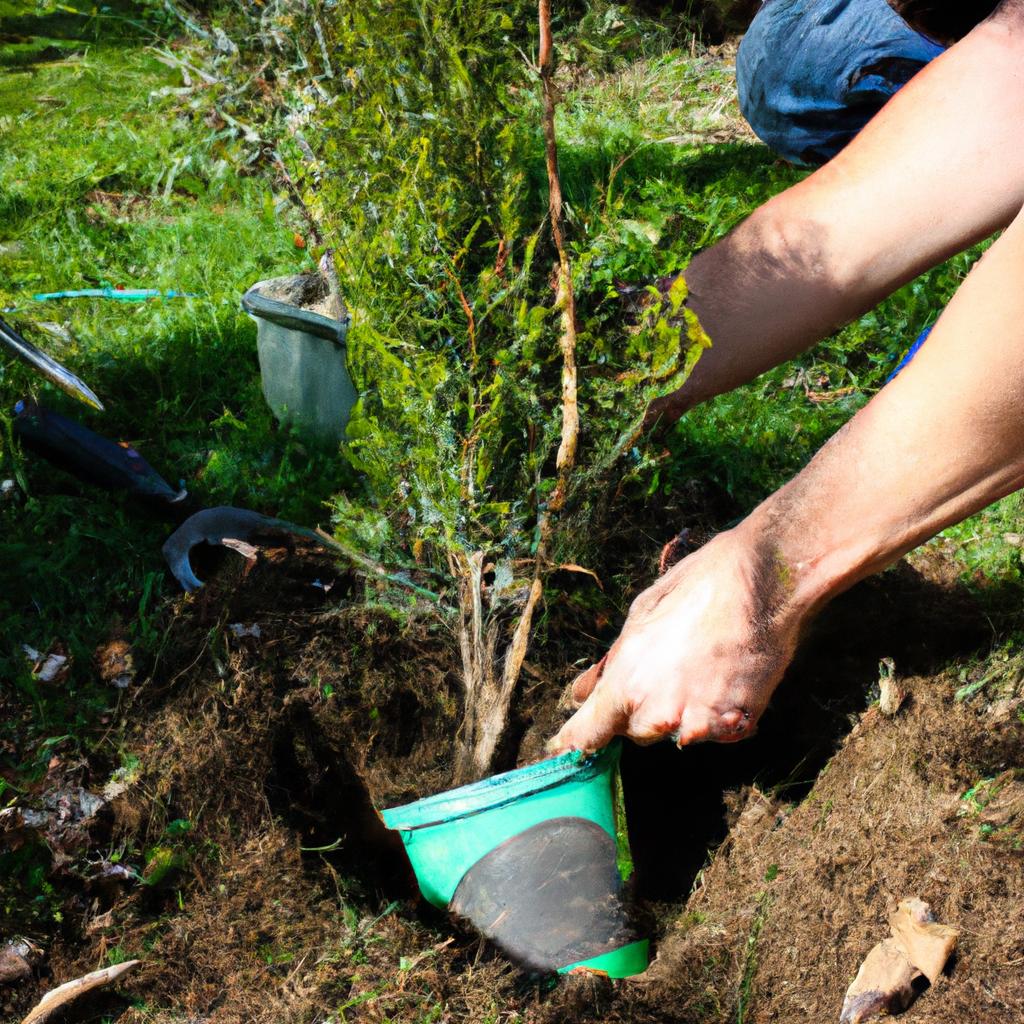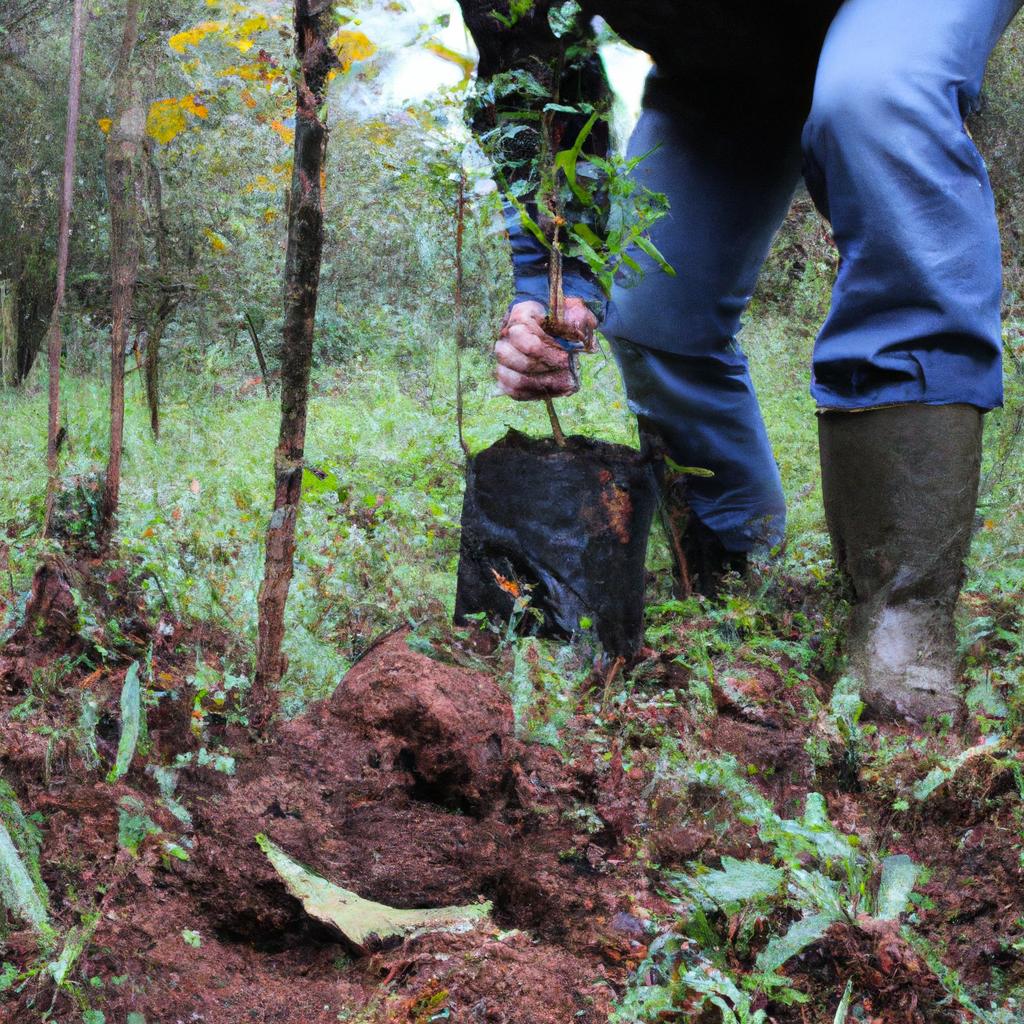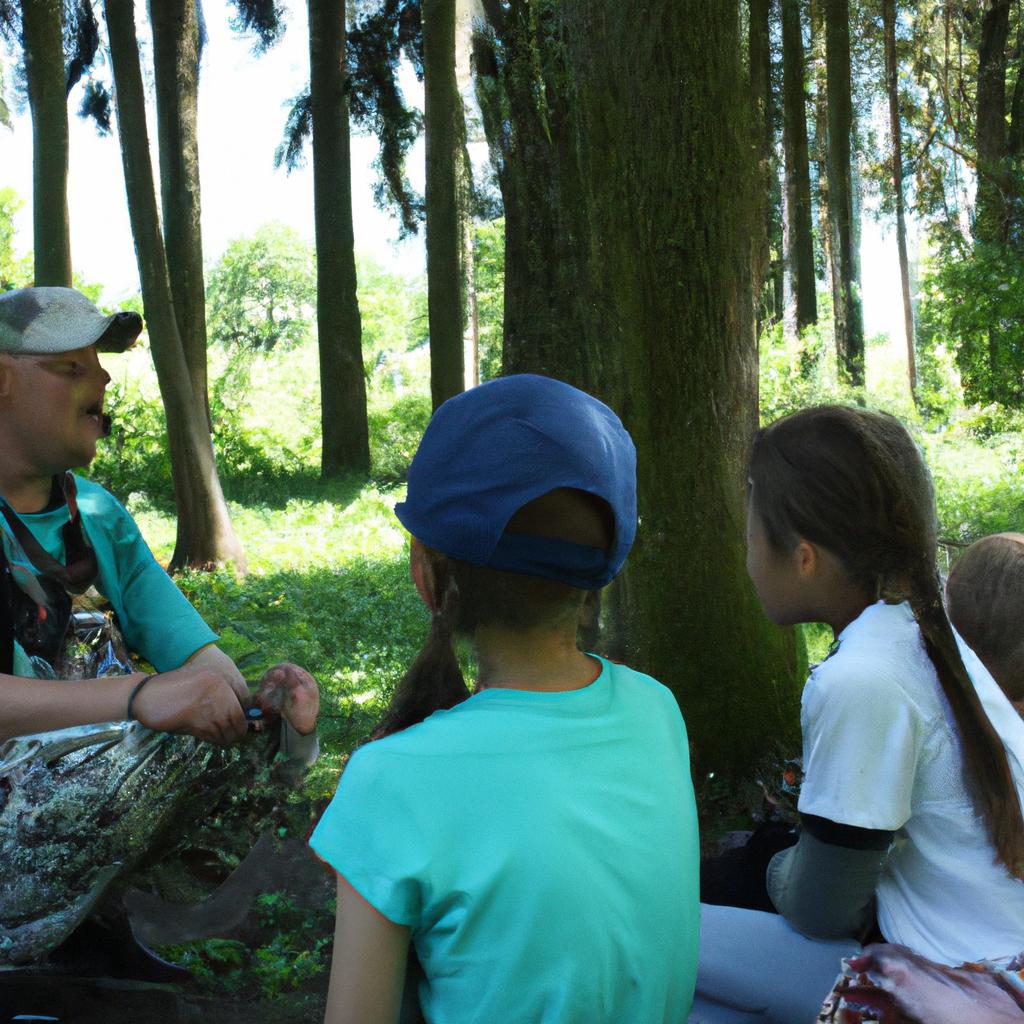Sustainable living practices have become increasingly important in today’s society due to the pressing need for environmental conservation. Environmental education plays a crucial role in promoting sustainable living practices by raising awareness about the impact of human activities on the environment and providing individuals with the knowledge and skills necessary to make informed decisions that minimize their ecological footprint. For instance, consider the case study of a hypothetical community that implemented an environmental education program focused on waste reduction and recycling. Through this program, residents were educated about the importance of reducing waste generation through conscious consumer choices and implementing effective recycling strategies. As a result, the community successfully reduced its overall waste output by 30% within six months, showcasing how environmental education can lead to tangible positive changes.
In addition to environmental education, conservation efforts are integral to achieving sustainability goals. Conservation refers to the preservation and protection of natural resources and ecosystems through various measures such as habitat restoration, species preservation, and sustainable resource management. By practicing conservation techniques, communities can ensure long-term ecological balance while improving their resilience against climate change impacts. For example, conservation initiatives may involve restoring degraded habitats to enhance biodiversity or implementing sustainable fishing practices to prevent overexploitation of marine resources. These actions not only contribute to preserving our planet’s natural heritage but also support local economies by promoting sustainable livelihoods and ecotourism opportunities.
Furthermore, sustainable living practices encompass a wide range of actions that individuals can take to reduce their environmental impact. This includes adopting energy-efficient technologies and practices such as using renewable energy sources like solar power, reducing water consumption through efficient fixtures and rainwater harvesting, and implementing green building techniques to minimize resource use and maximize energy efficiency. Sustainable transportation choices, such as walking, cycling, or using public transportation, can also greatly reduce carbon emissions from personal vehicles.
In terms of food consumption, sustainable living practices involve supporting local farmers and purchasing organic and seasonal produce to reduce the carbon footprint associated with long-distance transport and chemical-intensive agriculture. Additionally, reducing meat consumption or opting for plant-based diets can significantly decrease greenhouse gas emissions attributed to livestock farming.
Waste management is another crucial aspect of sustainable living. By practicing the principles of reduce, reuse, and recycle, individuals can minimize waste generation while conserving valuable resources. Composting organic waste not only diverts it from landfills but also creates nutrient-rich soil amendments for gardening purposes.
Overall, embracing sustainable living practices is essential for mitigating climate change, protecting biodiversity, conserving natural resources, and ensuring a healthy planet for future generations. Through environmental education programs focused on waste reduction/recycling initiatives and conservation efforts aimed at preserving ecosystems, communities can make significant strides towards achieving sustainability goals.
Understanding the Importance of Sustainability
Sustainability is a vital concept in today’s world, as it encompasses practices that promote environmental conservation and ensure the well-being of future generations. To grasp its significance, let us consider the case study of a small coastal community heavily reliant on fishing for their livelihood. Over time, due to unsustainable fishing practices and pollution, the once-thriving marine ecosystem has been severely depleted. This scenario highlights the urgent need for sustainable living practices and environmental education.
The Environmental Impact:
To comprehend why sustainability matters, we must first acknowledge the detrimental effects of human activities on our planet. Unsustainable practices such as deforestation, overfishing, and excessive use of fossil fuels lead to biodiversity loss, climate change, and resource depletion. These issues have far-reaching consequences not only for ecosystems but also for human health and well-being. For instance:
- Biodiversity Loss: The destruction of habitats results in the extinction of numerous plant and animal species essential for ecological balance.
- Climate Change: Excessive greenhouse gas emissions contribute to global warming, causing severe weather events like hurricanes and droughts.
- Resource Depletion: Non-renewable resources like oil are being consumed at an alarming rate, threatening future availability.
Consider these facts that emphasize the urgency of adopting sustainable practices:
- Every year approximately 8 million metric tons of plastic waste end up in our oceans, endangering marine life (National Geographic).
- Deforestation accounts for about 11% of global greenhouse gas emissions – more than all cars combined (World Wildlife Fund).
- By 2050, scientists predict there will be more plastic in the ocean than fish if current trends continue (Ellen MacArthur Foundation).
- Nearly one-third of food produced globally goes to waste each year; reducing this waste could help feed hungry populations (Food and Agriculture Organization).
Table – Ecological Consequences:
| Ecological Issue | Consequences |
|---|---|
| Biodiversity Loss | Disruption of ecosystem functioning and reduced resilience |
| Climate Change | Rising sea levels, increased temperatures, extreme weather |
| Resource Depletion | Scarce resources, economic instability |
In conclusion, understanding the importance of sustainability is crucial in addressing environmental challenges. Unsustainable practices have dire consequences for our planet’s ecosystems and ultimately affect human well-being. By recognizing the urgency of these issues and considering the emotional impact they have on us, we can start taking steps towards adopting a more sustainable lifestyle. The subsequent section will explore practical ways to embrace eco-friendly choices and contribute to a healthier future for both nature and humanity.
Adopting Eco-Friendly Lifestyle Choices
As we delve deeper into understanding sustainable living practices, it is crucial to recognize the significance of environmental education and conservation. By equipping individuals with knowledge about their surroundings and fostering a sense of responsibility towards the environment, we can pave the way for a more sustainable future. To illustrate this point, let’s consider a hypothetical scenario where an educational program on sustainability was implemented in a local community.
Imagine a small town that had been struggling with waste management issues for years. Residents were unaware of the impact their actions had on the environment and lacked proper knowledge on recycling and reducing waste. In response, an environmental organization initiated an educational campaign aimed at enlightening the community about sustainable practices. Through workshops, presentations, and hands-on activities, residents learned about composting techniques, recycling methods, and the importance of conserving resources.
The positive outcomes achieved through such initiatives are not limited to our hypothetical example alone; they extend far beyond individual communities. Here are some key benefits that arise from effective environmental education programs:
- Increased awareness: Education serves as a powerful tool in raising awareness about pressing ecological issues. When people gain insight into topics like climate change or habitat destruction, they become more motivated to take action.
- Empowerment: Environmental education empowers individuals by providing them with practical skills and tools necessary for creating positive change. This empowerment leads to increased confidence in making eco-friendly choices.
- Behavior modification: By instilling values centered around sustainability from an early age or engaging adults in learning opportunities later in life, we can shape behaviors that prioritize environmentally friendly habits.
- Community engagement: Environmental education brings together diverse groups within society who share common goals related to conservation efforts. This fosters collaboration and strengthens social ties among participants.
To further comprehend these advantages holistically, let us examine the following table showcasing data collected before and after implementing an environmental education program:
| Indicator | Pre-program (%) | Post-program (%) |
|---|---|---|
| Recycling rate | 25 | 60 |
| Energy consumption | High | Low |
| Water usage | Excessive | Moderate |
| Awareness of eco-issues | Limited | Extensive |
The data clearly demonstrates the positive impact that environmental education can have on individuals and communities. By promoting sustainable practices like recycling, reducing energy consumption, conserving water, and raising awareness about ecological issues, we foster a collective responsibility towards our planet.
As we move forward in exploring various aspects of sustainable living, it is essential to consider ways to reduce energy consumption. This aspect plays a significant role in minimizing our carbon footprint and ensuring long-term sustainability for future generations. So let’s delve into effective strategies for achieving this goal.
Reducing Energy Consumption
Transitioning from the previous section, where we discussed the importance of adopting eco-friendly lifestyle choices, let us now delve into another significant aspect of sustainable living practices: reducing energy consumption. By implementing effective strategies to minimize our energy usage, we can contribute towards environmental conservation and promote a greener future. To illustrate this point further, let’s consider an example:
Imagine a residential community called Green Meadows, consisting of 100 households committed to practicing sustainability. The residents of Green Meadows have collectively adopted various measures to reduce their overall energy consumption. Through their combined efforts, they have not only significantly decreased their carbon footprint but also inspired neighboring communities to follow suit.
To successfully reduce energy consumption on both individual and collective levels, it is essential to implement several key strategies:
- Enhancing home insulation: Properly insulating homes helps retain heat during colder months and reduces the need for excessive heating.
- Utilizing smart technologies: Installing programmable thermostats and motion sensors can optimize energy usage by automatically adjusting settings based on occupancy.
- Promoting natural lighting: Maximizing natural light sources within homes minimizes reliance on artificial lighting during daylight hours.
- Encouraging efficient appliance use: Choosing Energy Star-certified appliances and using them wisely (e.g., washing clothes in cold water) decreases electricity consumption.
Let us now explore these strategies further through the following table:
| Strategies to Reduce Energy Consumption |
|---|
| 1. Enhance home insulation |
| 2. Utilize smart technologies |
| 3. Promote natural lighting |
| 4. Encourage efficient appliance use |
By actively incorporating these practices into our daily lives, we not only benefit financially from reduced utility bills but also contribute significantly to preserving our environment for future generations. Transitioning seamlessly into the subsequent section about “Implementing Waste Management Strategies,” let us continue exploring how conscious actions can lead us closer to achieving sustainable living practices.
Implementing Waste Management Strategies
Building upon the concept of sustainable living practices, reducing energy consumption is an essential step towards achieving environmental education and conservation. By implementing effective strategies, individuals and communities can significantly reduce their carbon footprint and contribute to a more environmentally friendly future.
One example that demonstrates the impact of reducing energy consumption is the case study of Green Valley Community. Located in a remote area with limited access to conventional power sources, this community implemented various energy-saving measures. Through the installation of solar panels on rooftops, efficient insulation systems, and motion sensor lighting, Green Valley managed to decrease its overall energy usage by 30% within just six months.
To further inspire individuals and communities to adopt similar practices, let us explore some key strategies for reducing energy consumption:
- Conducting regular energy audits to identify areas where efficiency improvements can be made.
- Encouraging the use of natural light during daylight hours through architectural design or window placement.
- Promoting the switch to energy-efficient appliances and electronics.
- Educating individuals about proper heating and cooling techniques to optimize energy usage.
- Reduced reliance on non-renewable resources
- Lowered greenhouse gas emissions
- Preservation of natural habitats
- Enhanced long-term economic stability
In addition to these strategies, it is crucial to provide practical guidance for implementation. The table below outlines potential actions individuals can take at home or in their workplace:
| Actions | Benefits | Challenges |
|---|---|---|
| Switching off lights when not needed | Reduces electricity waste | Requires consistent habits |
| Utilizing smart power strips | Prevents standby power consumption | Initial cost investment |
| Setting programmable thermostats | Optimizes temperature control | Requires learning how to program |
| Utilizing natural ventilation | Reduces reliance on air conditioning | Dependence on weather conditions |
With a commitment to reducing energy consumption and adopting sustainable practices, individuals can contribute significantly to environmental conservation. This shift towards more responsible energy usage sets the stage for promoting other aspects of sustainability such as sustainable agriculture.
Transitioning into the subsequent section about “Promoting Sustainable Agriculture,” we recognize the vital connection between energy consumption and food production. By exploring methods that prioritize ecological balance and resource efficiency, we can create a harmonious relationship with our environment while ensuring food security for generations to come.
Promoting Sustainable Agriculture
Building upon the effective waste management strategies discussed above, the next crucial step towards sustainable living practices is promoting sustainable agriculture. By adopting methods that prioritize environmental conservation while ensuring food security, communities can significantly contribute to a more sustainable future.
Promoting Sustainable Agriculture:
To illustrate the importance of sustainable agriculture, let’s consider a hypothetical case study in which a small rural community decides to transition from conventional farming techniques to organic and regenerative practices. This shift not only improves soil health but also enhances biodiversity within the ecosystem surrounding their farmlands.
The benefits of promoting sustainable agriculture are manifold:
-
Preservation of Soil Health:
- Organic farming methods reduce soil erosion by maintaining natural habitats for microorganisms.
- Regenerative agricultural practices promote soil fertility through carbon sequestration and nutrient cycling.
-
Mitigation of Climate Change Impact:
- Livestock grazing systems that mimic natural ecosystems help restore grasslands and sequester atmospheric carbon.
- Agroforestry systems facilitate carbon storage by integrating trees with crops or livestock on farms.
-
Protection of Water Resources:
- By avoiding synthetic pesticides and chemical fertilizers, organic farming minimizes water contamination risks.
- Sustainable irrigation techniques such as drip irrigation conserve water resources by reducing evaporation losses.
-
Enhancement of Biodiversity:
- Maintaining diverse crop varieties cultivates resilience against pests and diseases without reliance on chemical interventions.
- Incorporating wildlife corridors and native plant species into agricultural landscapes fosters habitat connectivity and supports pollinators’ populations.
By embracing these principles of sustainable agriculture, communities can foster ecological balance while securing long-term food production. The case study mentioned demonstrates how even small-scale changes in farming practices can have significant positive impacts on both local environments and global sustainability efforts.
Protecting Biodiversity and Natural Habitats requires a comprehensive approach that extends beyond sustainable agriculture practices. By safeguarding natural habitats and preserving biodiversity, we can ensure the long-term health and resilience of our ecosystems.
Protecting Biodiversity and Natural Habitats
Building upon the foundation of sustainable agriculture, it is crucial to address another vital aspect of achieving sustainable living practices – protecting biodiversity and natural habitats. By conserving and preserving our ecosystems, we can ensure the long-term health and resilience of our planet.
Section H2: Protecting Biodiversity and Natural Habitats
To illustrate the significance of protecting biodiversity, let us consider a hypothetical case study involving a coastal region known for its diverse marine life. This area has been experiencing habitat degradation due to pollution from nearby industries, resulting in declining fish populations and coral bleaching events. Implementing conservation strategies will not only safeguard this unique ecosystem but also preserve numerous endangered species that rely on these habitats for survival.
The Importance of Protecting Biodiversity:
- Biodiversity ensures ecological balance by supporting various food chains and maintaining natural processes.
- Preserving native plant species helps prevent soil erosion, maintain water quality, and enhance carbon sequestration.
- Conserved habitats provide valuable opportunities for scientific research, education, recreation, and ecotourism.
- Protecting biodiversity supports local communities dependent on nature-based livelihoods such as fishing or eco-friendly tourism.
Table Markdown Format:
| Reasons for Protecting Biodiversity | Examples |
|---|---|
| Ecological Balance | Maintaining predator-prey relationships |
| Ecosystem Services | Pollination by bees; decomposition by microorganisms |
| Scientific Research Opportunities | Studying rare plants or animals |
| Economic Benefits | Revenue generated through wildlife tourism or sustainable harvesting |
Bullet Point List Markdown Format:
- Witnessing thriving ecosystems teeming with vibrant flora and fauna instills awe-inspiring beauty in nature’s intricate web of life.
- The loss of biodiversity threatens future generations’ ability to experience the wonders of diverse ecosystems.
- Preserving natural habitats ensures a sustainable future for all living beings, as our own well-being is intricately linked to the health of the planet.
- By protecting biodiversity and natural habitats, we actively contribute towards mitigating climate change and maintaining ecological balance.
In summary, safeguarding biodiversity and natural habitats is crucial in creating a sustainable future. The hypothetical case study highlights the need for immediate action to protect fragile ecosystems that are vulnerable to human activities. Through conservation efforts driven by environmental education and awareness, we have the opportunity to preserve Earth’s rich biodiversity for generations to come. Let us embrace these practices and work collectively towards a harmonious coexistence with nature.




